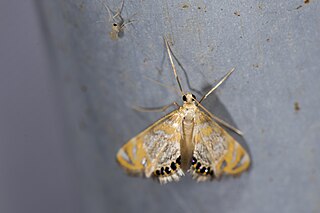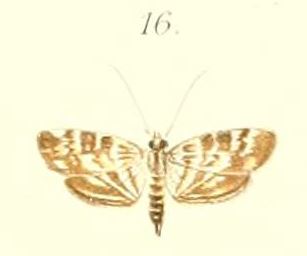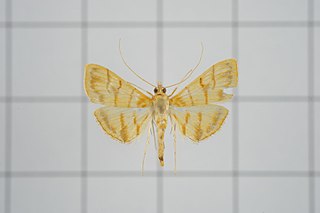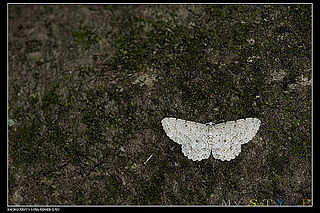
Grass skippers or banded skippers are butterflies of the subfamily Hesperiinae, part of the skipper family, Hesperiidae. The subfamily was established by Pierre André Latreille in 1809.

Spilomelinae is a very species-rich subfamily of the lepidopteran family Crambidae, the crambid snout moths. With 4,135 described species in 344 genera worldwide, it is the most speciose group among pyraloids.

Eoophyla is a genus of moths of the family Crambidae. It was erected by Charles Swinhoe in 1900.

Nymphicula is a genus of moths of the family Crambidae.

Nymphula is a genus of moths of the family Crambidae. It was described by Franz von Paula Schrank in 1802. They have aquatic larvae.

Parapoynx is a genus of moths of the family Crambidae described by Jacob Hübner in 1825.

Psara is a genus of moths in the family Crambidae described by Snellen in 1875.

Symmoracma is a monotypic moth genus of the family Crambidae described by Edward Meyrick in 1894. Its only species, Symmoracma minoralis, described by Snellen in 1880, is found in Indonesia, Papua New Guinea, Taiwan, China and Australia, where it has been recorded from Queensland.

Tabidia is a genus of moths of the family Crambidae described by Pieter Cornelius Tobias Snellen 1880.

Mocis is a genus of moths in the family Erebidae. The genus was erected by Jacob Hübner in 1823.

Acerbas is an Indomalayan genus of skipper butterflies.

Parapoynx diminutalis is a species of moth of the family Crambidae described by Pieter Cornelius Tobias Snellen in 1880. It is endemic to south-east Asia, including the Northern Territory, Queensland and New South Wales in Australia, but has since been found in the United Kingdom and the United States. It is also found in Africa, where it has been recorded from Egypt, Sudan, Ethiopia, Kenya, Uganda, Tanzania, Zambia, Zimbabwe, Malawi, South Africa, Botswana, Angola, the Republic of the Congo, Nigeria and Madagascar.

Xestia smithii, or Smith's dart, is a moth of the family Noctuidae. The species was first described by Pieter Cornelius Tobias Snellen in 1896. It is found across northern North America from Newfoundland to Alaska. In the eastern United States it occurs from Maine to Virginia and south along the Appalachians to North Carolina. In the west it is found in the Black Hills in western South Dakota and north-eastern Wyoming, in the Rocky Mountains from Montana to New Mexico, south-eastern Arizona, and from Washington to east central California. It has recently been recorded from Tennessee.

Deanolis sublimbalis, the red banded mango caterpillar, is a moth of the family Crambidae. The species was first described by Pieter Cornelius Tobias Snellen in 1899. It is found in India and Indonesia (Sulawesi), Papua New Guinea, Myanmar, Thailand, China, Brunei and the Philippines. In 1990 it was first recorded in Australia in the Torres Strait and in 2001 it was detected on the Australian mainland in the Northern Peninsula Area at the tip of the Cape York Peninsula in Queensland.

Pseudoneptis is a butterfly genus in the family Nymphalidae. It contains only one species Pseudoneptis bugandensis, the blue sailer or blue sergeant. It is found in Guinea, Sierra Leone, Liberia, Ivory Coast, Ghana, Togo, Nigeria, Cameroon, the Republic of the Congo, the Central African Republic, Angola, the Democratic Republic of the Congo, Uganda, Kenya, Sudan, Tanzania and Zambia. The habitat consists of forest with a canopy, including dry and disturbed forests.
Elophila difflualis is a moth of the family Crambidae. The species was first described by Pieter Cornelius Tobias Snellen in 1880. It is found in South-East Asia, in Australia and Réunion but has also be introduced to the United Kingdom.
Nymphicula queenslandica is a moth in the family Crambidae. It was described by George Hampson in 1917. It is found in Australia, where it has been recorded from Queensland.

Pagyda botydalis is a moth in the family Crambidae. It was described by Snellen in 1880. It is found on Sumatra, in north-eastern India, Sri Lanka, Taiwan, Papua New Guinea and Australia, where it has been recorded from Queensland.

Catoria sublavaria is a moth of the family Geometridae described by Achille Guenée in 1857. It is found in the tropics of India, Sri Lanka, Myanmar, towards New Guinea, to the Bismarck Islands and Taiwan.

Delias rosenbergii, Rosenberg's painted Jezebel, is a butterfly in the family Pieridae. It was described by Samuel Constantinus Snellen van Vollenhoven in 1865. It is found on the Wallace line. The name honours William Frederick Henry Rosenberg.

















